Narrative Analysis: Case studies in heat resilience
Organization: GHHIN, WMO, UNDRR, Duke
Year: 2025

As climate change intensifies, extreme heat is emerging as a defining public health and development challenge across the globe. From heatwaves that overwhelm hospitals to chronic heat and urban heat islands that threaten vulnerable communities, the risks are growing, and so is the need for effective, coordinated responses.
This narrative analysis highlights how twelve countries are confronting the realities of extreme heat through diverse governance models, partnerships, and innovations.
The case studies span multiple regions and development contexts—Argentina, Australia, Bangladesh, Canada, Ecuador, Egypt, France, India, Senegal, South Korea, the United Kingdom, and the United States—offering a cross-cutting view of what’s working, where gaps remain, and how national strategies are evolving in the face of escalating climate threats.
Rather than a one-size-fits-all approach, these profiles underscore the importance of adaptable, community-centred solutions, multi-sector collaboration, and strong institutional frameworks. By capturing lessons, successes, and persistent challenges, this analysis contributes to the growing global dialogue on how to govern for resilience in a warming world.
This collection of case studies complements the broader efforts led by the Global Heat Health Information Network (GHHIN), UN Office for Disaster Risk Reduction (UNDRR), and the World Meteorological Organization (WMO) in support of the United Nations Secretary-General’s Call to Action on Extreme Heat (2024).